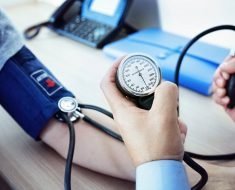Skin cancer: Dr Chris outlines the signs of a melanoma
When you subscribe we will use the information you provide to send you these newsletters. Sometimes they’ll include recommendations for other related newsletters or services we offer. Our Privacy Notice explains more about how we use your data, and your rights. You can unsubscribe at any time.
Skin cancer is by far the most common type of cancer to be diagnosed in the UK, but there are still plenty of people that are unaware they’re at risk. It’s essential that you regularly check your skin for the key signs of cancer – particularly if you’ve been spending more time outdoors.
Skin helps to protect the inside of our bodies from damage and infection.
It’s also used to manufacture vitamin D, as well as maintaining our body temperature.
But the sun and ultraviolet radiation and damage the skin, and subsequently, lead to skin cancer.
Most skin cancers are caused by sun exposure, and you’re more likely to develop it if you spend more time outdoors.

Diagnosing skin cancer early is crucial for treatment, which is why everybody should know what signs to look out for.
Regularly examining your skin is the easiest way to know if you’re at risk.
You should particularly be looking out for changes to any existing moles.
Speak to a doctor or dermatologist if you’re unsure about the growths on your skin.
DON’T MISS
The hidden warning sign of skin cancer under your nails exposed
How to get rid of visceral fat: The best drink to avoid
Skin cancer symptoms: Three non-skin-related signs
Common skin cancer symptoms
Unusual skin growth
Sore that doesn’t go away
New rash or nodule
Irregular patch on the surface of the skin
Spots that ooze or bleed easily

“Regular examination of the skin for any new or unusual growths, or changes in the size, shape or colour of an existing spot, is key to finding and treating skin cancers early,” said the Cancer Treatment Centers of America.
“If you find anything suspicious, you should discuss it with your primary care physician or a dermatologist.
“While many skin cancers develop in areas exposed to the sun, they may also develop in areas that are usually hidden from the sun. It is important to examine all of these areas.
“In addition to examining the legs, trunk, arms, face and neck, it is important to look for signs of skin cancer in the areas between the toes, underneath nails, palms of the hands and soles of the feet, genitals and even the eyes.”
More than 150,000 people are diagnosed with non-melanoma skin cancer every year in the UK.
But the number could be much higher, because it’s often left undiagnosed.
Melanoma, the more severe type of skin cancer, affects around 13,500 people every year.
Speak to a doctor if you’re worried about the signs or symptoms of skin cancer.
Source: Read Full Article





